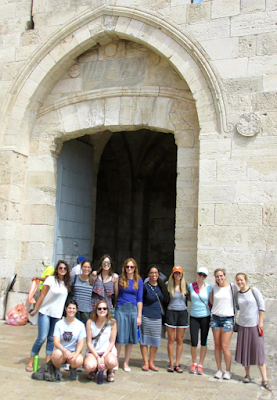The first time I stood in front
of the Kotel (Western Wall) I didn’t know what to think. On the one hand, I was
praying at one of the holiest sites for the Jewish people. It was incredible to
know that this is where the Beit Hamikdash (Temple) once stood. This is
where my ancestors would travel to on the high holy days and where the center
of Judaism once was and still is, thousands of years later!
I thought I felt connected to Jerusalem before but after
spending even a little bit of time here, I truly feel like its home. I feel
comfortable walking around the winding streets of the Old City discovering new
nooks and crannies, meeting people and tasting all the delightful food that
there are here. It never gets old, there is always something new to see or
experience.
On our most recent Mayanot tour
of the area, with all 30 women in the Summer Mayanot Women’s Learning Program, I learnt
more then I could have imagined about the historical and spiritual significance
of this amazing place. So much of the history of our people is tied to this land and these cobblestone streets. I feel that the more I learn and educate myself, the closer I feel connected
to my ancestry and what has happened to our people, as a nation!
It really is illustrative of why
Israel is the Jewish homeland. Regardless, of where Jews are coming from or
what they believe, it is easy to feel a sense of belonging within the walls of
the Old City and within Jerusalem, in general. How connected we are to this place,
how could it be any other way!
I think my favorite experience coming
to the kotel is Friday night, during Kabbalat Shabbat (Friday evening prayers). It is an amazing scene and one I have been lucky enough to see on
an almost regular basis. Everyone is gathered in their best Shabbat clothing
from more religious men and women, to Taglit Birthright Israel groups singing “Am Yisroel
Chai” as loudly as possible, the diversity is astounding and so beautiful. It
is one of the most amazing sights to witness, as everyone scurries to find their
friends and family, so they can head to their Shabbat meals, you are struck
with the realization that you are a part of something so much bigger then
yourself, something that feels so important with such historical and spiritual
significance.
The main point of Torah, as I
understand it, is to love your fellow Jew as you love yourself, and walking
around the Old City you realize how diverse the Jewish people are and how much variety
we have between us. At the same time we are all connected, everyone is working
towards the same goals and praying to the same G-d.
It is easy to forget that this
unity exists in the hustle and bustle of daily life in Jerusalem. But, the Old
City is almost like a secret oasis frozen in time. It is part of the city and
modern life but also not at all. That’s what makes it so incredible. Walking
through the Old City connects you to another time; it’s a tangible part of the
greater Jewish timeline. Next time you are walking in the Old City, stop and
look around, take in the sounds and the sights and realize that you are a part
of something much bigger than yourself.
Written by: Jennie Maibor, Current Student of the Mayanot Women's Learning Program in Jerusalem



